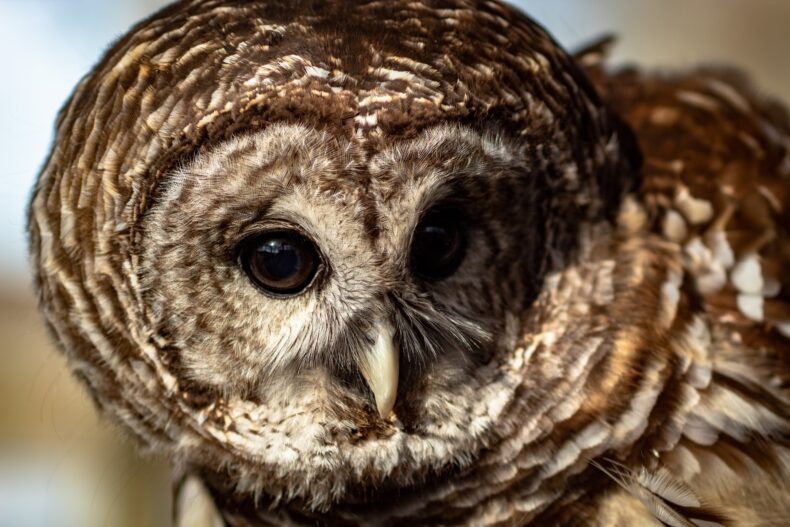
I had a conversation with an owl the other night. It was a barred owl, a pretty common species in the woods around our cabin in central Virginia. The bird got going early—well before dusk—and I happened to be outside with my native wooden flute (purchased from this lovely flutemaker in Canada), so I found similar notes and replied in the same pattern. There was a pause while cicadas and crickets took a turn. Then, the owl again. Four quick hoots, repeated twice, the final one dropping off into a guttural drag. I waited a few beats, lets the insects hum some more, then played again, the eight notes. Seconds passed. Then, the owl.
Barred owls aren’t just one-note birds: They have a variety of calls, more than a dozen by some counts, including one that you’d swear came from a monkey. But this was the one people like to say sounds like “Who cooks for you? Who cooks for you all?” (I’m not sold on that comparison, but it endures.)
It’s very possible, likely, even, that my flute playing had nothing to do with the owl’s decision to keep hooting. In my experience these owls will repeat the sequence at least a few times over a couple of minutes, regardless of any back talk. But I like to think we were conversing. There’s something magical about hearing a wild animal respond to you the way he would to his own kind, as if what you said was meaningful enough in his language to warrant a reply.
If barred owls weren’t so vocal, I wouldn’t know for sure they were around. Only once did I spy one, barely, as I pointed my flashlight beam into the big oak where a call seemed to be coming from. It was fully dark, but I glimpsed the bird’s eyeshine before he swooped toward me and then away, over my head. (A little anatomy: An owl’s eyes are super reflective, having an extra layer called the tapetum lucidum that snags light passing through the retina and bounces it back to what are already very sensitive rods.) The swoop was almost silent; I felt it more than heard it. Which is the owl’s way: The structure and texture of the wing feathers lets them funnel air very quietly by breaking up the turbulence that would otherwise whoosh.
But it was the calls moving through the air more than the bird’s anatomy that interested me that night. I thought about how the animal’s vocalizations in a sense fill a niche much as the physical animal does. It’s a more temporary residency, but still. I had the same notion some months before while lying in my tent in a rainforest in Borneo. I was listening, on my first night there, to the delightfully unfamiliar calls of wild things coming awake just before dawn. As cricket chirps were topped by a bird’s song that gave way to monkey chatter, I envisioned the soundscape in 3D with each unique noise—with its own pitch and volume and frequency—rushing in to inhabit an empty spot, standing tall to make itself known—ta da!–and then vacating just as quickly. Picture Tom Cruise in Minority Report flinging bits of data around in space with his finger…sliding this bit over, that one up, another one off screen, a new one in to replace it. That’s sort of how I saw it.
So, I think of animals as competing not just for a physical niche but for an aural one as well—a slot in the soundspace not yet taken that they can fill with chatter and alarms and music and be heard despite the din. It’s another way to make oneself known in a crowd. The variety makes it all possible: An elephant sending low-frequency rumbles through the Earth reaches her intended even as lions roar and cicadas scream. Like a lioness intent on spotting the weakest gazelle in the herd, an animal can hear a familiar voice and a known language rising above all others.
I don’t know that this is a terribly profound notion, but conversing with the owl, I realized that my flute toots were taking up one tiny pocket of aural space, filling that sound niche just for a moment, then flitting offscreen, leaving that spot vacant for the owl’s reply. Profound or no, it was kind of a neat way to think about it.
–Photo by Joshua J. Cotten on Unsplash
🙂